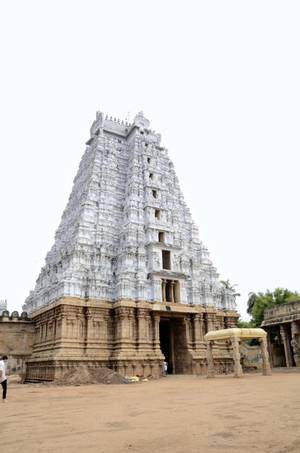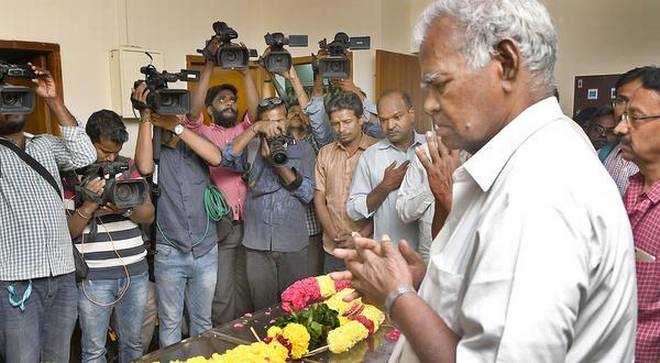Monthly Archives: January 2018
27
26
25
24
23
22
The legend of Vellayi

Eastern gopuram, symbol of sacrifice
On the eastern entrance of the Srirangam temple, there stands a white tower, popularly known as the Vellayi Gopuram. Residents of Srirangam call this east tower as the Vellai Gopuram. It is generally believed that the tower is so called since it has been painted white by the temple authorities. But the tower has actually been named after a Devadasi called Vellayi who had sacrificed her life to protect the idol of Namperumal from the Sultanate forces who had invaded the temple.
Srirangam was attacked by the Sultanate forces in the year 1323 during the Tamil month of Vaikasi. Nearly, 12,000 residents of Srirangam island had laid down their lives fighting to protect the temple. The forces attacked the temple and Lord Ranganatha’s jewels and the temple gold were taken away.
The forces also wanted to seize the idol of Namperumal, which they believed was made of pure ‘Abaranji’ gold. They searched for the idol but the Vaishnavite Acharya, Pillailokacharya had taken the idol away and fled to Madurai. (The idol of Namperumal that left Srirangam in 1323 returned back only in 1371).
Unable to locate the idol, the Sultanate forces killed the temple authorities and later launched a massive hunt for Pillailokacharya and Namperumal.
Fearing that the forces would capture the Acharya and the idol, Vellayi, performed a dance before the commander of the forces thus gaining time for Pillailokacharya to escape with the idol.
Her dance lasted for hours together and finally she took the commander to the eastern gopuram and pushed him down. After killing him, Vellayi jumped to her death from the tower chanting the name of Ranganathar.
Hailing Vellayi’s sacrifice, the chief of Vijayanagara forces, Kempanna, who drove away the Sultanate forces, named the tower after her. The gopuram continues to be painted white in her memory.
source: http://www.thehindu.com / The Hindu / Home> News> Cities> Tiruchirapalli / by T.A. Narasimhan / January 04th, 2012 & updated July 25th, 2016
20
Journalist, theatre personality Gnani dead
In a career spanning four decades, he directed several plays and nearly 40 documentary films
Journalist, theatre personality and literary critic Gnani (born V. Sankaran) died here in the early hours of Monday following a cardiac arrest. He was 64. He is survived by wife Padmavathi and son, Manush Nandan, a cinematographer.
Gnani had been suffering from a kidney ailment and undergoing dialysis.
A native of Chenglapattu, Gnani had begun his career at Indian Express in the mid-1970s. Veteran Tamil playwright Indira Parthasarathy recalls that he had met Gnani for the first time in 1976 when the latter was a cub reporter and had come to interview him (Prof. Parthasarathy). “I could feel even then that that he was a bright guy. My assessment of him continues even now. He was an amazing, fearless and versatile personality,” the playwright points out, adding that he dedicated to Gnani’s memory the lifetime achievement award that he received on the second day of The Hindu Lit for Life.
Gnani was trained by S. Ramanujam, G. Sankara Pillai and Badal Sircar, all doyens of Indian theatre. Originally a member of “Koothu-P-Pattarai,” a theatre group, he went on to set up in 1978 ‘Pareeksha,’ whose maiden play was Porvai Porthiya Udalgal of Prof. Parthasarathy.
“The play’s central character was a woman, ‘Vasanthi,’ and Gnani could not find a suitable person. But he had the ingenuity to use the voice of a woman (Gnani’s stepsister) instead. The impact was great, though there was no woman physically on the stage to represent ‘Vasanthi’,” says the playwright, adding that he had come to Chennai from New Delhi, where he was living then, to see the play.
When the influence of cinema and television was growing in the early 1990s, ‘Pareeksha’ had staged a play every week along with others in Chennai.
Equal space
In his 40-year-long career, Gnani had directed plays based on the works of several prominent writers, including Harold Pinter, Bertolt Brecht, J.B. Priestley, Vijay Tendulkar, Ashokamitran, Sundara Ramaswami and Jeyanthan. Gnani had produced around 40 documentary films and half-a-dozen tele films. Among them was Ayya, which was based on Dravidian movement’s prominent figure, E.V. Ramasamy.
Actor Balasingham, who began his career with ‘Pareeksha,’ said Gnani, as the theatre group’s leader, gave equal space to everyone and he was very friendly to all. “As the director, he never indulged in show off,” says the actor.
In his career as journalist, Gnani set up a Tamil periodical, Dheem Tharikada. He was also in charge of editorial production of the Sunday magazine section of Murasoli in late 1980s and Junior Post in the early 1990s.
His columns, O Pakkangal in popular Tamil journals became a big hit and sometimes, his views triggered controversies.
T. N. Gopalan, veteran journalist, and a colleague at the Express, says “I have always envied his uncompromising personality. His determination to fight back and stand for values that he cherished has a legacy for coming generations of journalists.”
Minister Ma Foi K. Pandiarajan, veteran CPI leader R. Nallakannu and Bharatiya Janata Party state president Tamilisai Soundarajan visited the house of Gnani at K. K. Nagar and expressed their condolences to the journalist’s family.
source: http://www.thehindu.com / The Hindu / Home> News> States> Tamil Nadu / by T. Ramakrishnan / Chennai – January 16th, 2018
